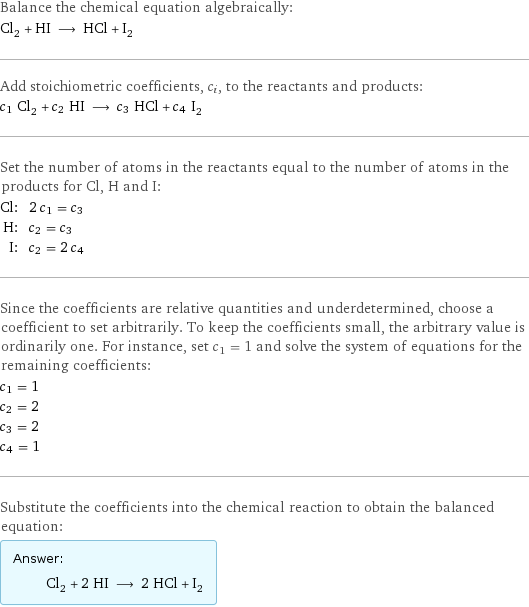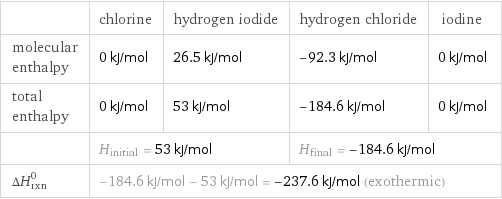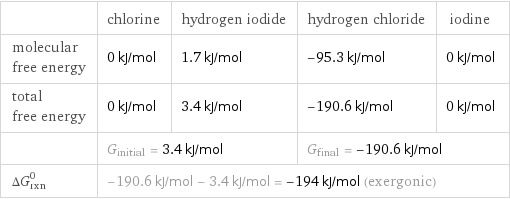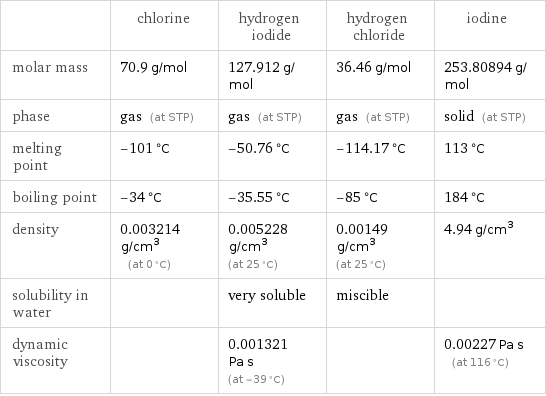Input interpretation

Cl_2 chlorine + HI hydrogen iodide ⟶ HCl hydrogen chloride + I_2 iodine
Balanced equation

Balance the chemical equation algebraically: Cl_2 + HI ⟶ HCl + I_2 Add stoichiometric coefficients, c_i, to the reactants and products: c_1 Cl_2 + c_2 HI ⟶ c_3 HCl + c_4 I_2 Set the number of atoms in the reactants equal to the number of atoms in the products for Cl, H and I: Cl: | 2 c_1 = c_3 H: | c_2 = c_3 I: | c_2 = 2 c_4 Since the coefficients are relative quantities and underdetermined, choose a coefficient to set arbitrarily. To keep the coefficients small, the arbitrary value is ordinarily one. For instance, set c_1 = 1 and solve the system of equations for the remaining coefficients: c_1 = 1 c_2 = 2 c_3 = 2 c_4 = 1 Substitute the coefficients into the chemical reaction to obtain the balanced equation: Answer: | | Cl_2 + 2 HI ⟶ 2 HCl + I_2
Structures

+ ⟶ +
Names

chlorine + hydrogen iodide ⟶ hydrogen chloride + iodine
Reaction thermodynamics
Enthalpy

| chlorine | hydrogen iodide | hydrogen chloride | iodine molecular enthalpy | 0 kJ/mol | 26.5 kJ/mol | -92.3 kJ/mol | 0 kJ/mol total enthalpy | 0 kJ/mol | 53 kJ/mol | -184.6 kJ/mol | 0 kJ/mol | H_initial = 53 kJ/mol | | H_final = -184.6 kJ/mol | ΔH_rxn^0 | -184.6 kJ/mol - 53 kJ/mol = -237.6 kJ/mol (exothermic) | | |
Gibbs free energy

| chlorine | hydrogen iodide | hydrogen chloride | iodine molecular free energy | 0 kJ/mol | 1.7 kJ/mol | -95.3 kJ/mol | 0 kJ/mol total free energy | 0 kJ/mol | 3.4 kJ/mol | -190.6 kJ/mol | 0 kJ/mol | G_initial = 3.4 kJ/mol | | G_final = -190.6 kJ/mol | ΔG_rxn^0 | -190.6 kJ/mol - 3.4 kJ/mol = -194 kJ/mol (exergonic) | | |
Equilibrium constant
![Construct the equilibrium constant, K, expression for: Cl_2 + HI ⟶ HCl + I_2 Plan: • Balance the chemical equation. • Determine the stoichiometric numbers. • Assemble the activity expression for each chemical species. • Use the activity expressions to build the equilibrium constant expression. Write the balanced chemical equation: Cl_2 + 2 HI ⟶ 2 HCl + I_2 Assign stoichiometric numbers, ν_i, using the stoichiometric coefficients, c_i, from the balanced chemical equation in the following manner: ν_i = -c_i for reactants and ν_i = c_i for products: chemical species | c_i | ν_i Cl_2 | 1 | -1 HI | 2 | -2 HCl | 2 | 2 I_2 | 1 | 1 Assemble the activity expressions accounting for the state of matter and ν_i: chemical species | c_i | ν_i | activity expression Cl_2 | 1 | -1 | ([Cl2])^(-1) HI | 2 | -2 | ([HI])^(-2) HCl | 2 | 2 | ([HCl])^2 I_2 | 1 | 1 | [I2] The equilibrium constant symbol in the concentration basis is: K_c Mulitply the activity expressions to arrive at the K_c expression: Answer: | | K_c = ([Cl2])^(-1) ([HI])^(-2) ([HCl])^2 [I2] = (([HCl])^2 [I2])/([Cl2] ([HI])^2)](../image_source/956a3a7b0d94a7fa733e791a0f382892.png)
Construct the equilibrium constant, K, expression for: Cl_2 + HI ⟶ HCl + I_2 Plan: • Balance the chemical equation. • Determine the stoichiometric numbers. • Assemble the activity expression for each chemical species. • Use the activity expressions to build the equilibrium constant expression. Write the balanced chemical equation: Cl_2 + 2 HI ⟶ 2 HCl + I_2 Assign stoichiometric numbers, ν_i, using the stoichiometric coefficients, c_i, from the balanced chemical equation in the following manner: ν_i = -c_i for reactants and ν_i = c_i for products: chemical species | c_i | ν_i Cl_2 | 1 | -1 HI | 2 | -2 HCl | 2 | 2 I_2 | 1 | 1 Assemble the activity expressions accounting for the state of matter and ν_i: chemical species | c_i | ν_i | activity expression Cl_2 | 1 | -1 | ([Cl2])^(-1) HI | 2 | -2 | ([HI])^(-2) HCl | 2 | 2 | ([HCl])^2 I_2 | 1 | 1 | [I2] The equilibrium constant symbol in the concentration basis is: K_c Mulitply the activity expressions to arrive at the K_c expression: Answer: | | K_c = ([Cl2])^(-1) ([HI])^(-2) ([HCl])^2 [I2] = (([HCl])^2 [I2])/([Cl2] ([HI])^2)
Rate of reaction
![Construct the rate of reaction expression for: Cl_2 + HI ⟶ HCl + I_2 Plan: • Balance the chemical equation. • Determine the stoichiometric numbers. • Assemble the rate term for each chemical species. • Write the rate of reaction expression. Write the balanced chemical equation: Cl_2 + 2 HI ⟶ 2 HCl + I_2 Assign stoichiometric numbers, ν_i, using the stoichiometric coefficients, c_i, from the balanced chemical equation in the following manner: ν_i = -c_i for reactants and ν_i = c_i for products: chemical species | c_i | ν_i Cl_2 | 1 | -1 HI | 2 | -2 HCl | 2 | 2 I_2 | 1 | 1 The rate term for each chemical species, B_i, is 1/ν_i(Δ[B_i])/(Δt) where [B_i] is the amount concentration and t is time: chemical species | c_i | ν_i | rate term Cl_2 | 1 | -1 | -(Δ[Cl2])/(Δt) HI | 2 | -2 | -1/2 (Δ[HI])/(Δt) HCl | 2 | 2 | 1/2 (Δ[HCl])/(Δt) I_2 | 1 | 1 | (Δ[I2])/(Δt) (for infinitesimal rate of change, replace Δ with d) Set the rate terms equal to each other to arrive at the rate expression: Answer: | | rate = -(Δ[Cl2])/(Δt) = -1/2 (Δ[HI])/(Δt) = 1/2 (Δ[HCl])/(Δt) = (Δ[I2])/(Δt) (assuming constant volume and no accumulation of intermediates or side products)](../image_source/1b2d4e95355788be5b05a8833aed9385.png)
Construct the rate of reaction expression for: Cl_2 + HI ⟶ HCl + I_2 Plan: • Balance the chemical equation. • Determine the stoichiometric numbers. • Assemble the rate term for each chemical species. • Write the rate of reaction expression. Write the balanced chemical equation: Cl_2 + 2 HI ⟶ 2 HCl + I_2 Assign stoichiometric numbers, ν_i, using the stoichiometric coefficients, c_i, from the balanced chemical equation in the following manner: ν_i = -c_i for reactants and ν_i = c_i for products: chemical species | c_i | ν_i Cl_2 | 1 | -1 HI | 2 | -2 HCl | 2 | 2 I_2 | 1 | 1 The rate term for each chemical species, B_i, is 1/ν_i(Δ[B_i])/(Δt) where [B_i] is the amount concentration and t is time: chemical species | c_i | ν_i | rate term Cl_2 | 1 | -1 | -(Δ[Cl2])/(Δt) HI | 2 | -2 | -1/2 (Δ[HI])/(Δt) HCl | 2 | 2 | 1/2 (Δ[HCl])/(Δt) I_2 | 1 | 1 | (Δ[I2])/(Δt) (for infinitesimal rate of change, replace Δ with d) Set the rate terms equal to each other to arrive at the rate expression: Answer: | | rate = -(Δ[Cl2])/(Δt) = -1/2 (Δ[HI])/(Δt) = 1/2 (Δ[HCl])/(Δt) = (Δ[I2])/(Δt) (assuming constant volume and no accumulation of intermediates or side products)
Chemical names and formulas

| chlorine | hydrogen iodide | hydrogen chloride | iodine formula | Cl_2 | HI | HCl | I_2 Hill formula | Cl_2 | HI | ClH | I_2 name | chlorine | hydrogen iodide | hydrogen chloride | iodine IUPAC name | molecular chlorine | hydrogen iodide | hydrogen chloride | molecular iodine
Substance properties

| chlorine | hydrogen iodide | hydrogen chloride | iodine molar mass | 70.9 g/mol | 127.912 g/mol | 36.46 g/mol | 253.80894 g/mol phase | gas (at STP) | gas (at STP) | gas (at STP) | solid (at STP) melting point | -101 °C | -50.76 °C | -114.17 °C | 113 °C boiling point | -34 °C | -35.55 °C | -85 °C | 184 °C density | 0.003214 g/cm^3 (at 0 °C) | 0.005228 g/cm^3 (at 25 °C) | 0.00149 g/cm^3 (at 25 °C) | 4.94 g/cm^3 solubility in water | | very soluble | miscible | dynamic viscosity | | 0.001321 Pa s (at -39 °C) | | 0.00227 Pa s (at 116 °C)
Units
